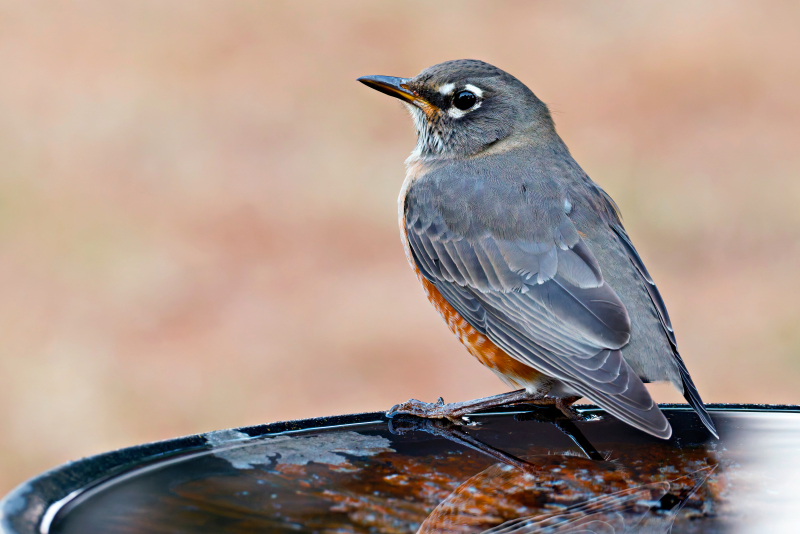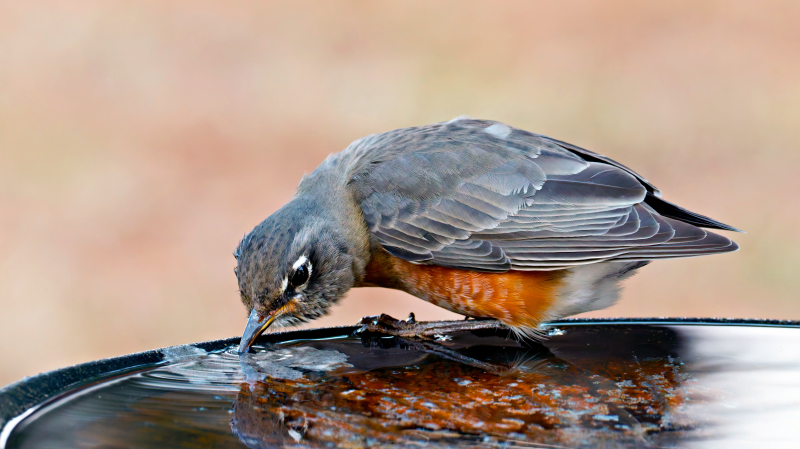Recently, an American Robin visited the birdbath in my yard, giving me a chance to photograph it up close. What caught my attention right away was that the robin was missing its tail feathers. This is not the first time I’ve encountered birds without tail feathers, such as the Tailless Tufted Titmouse I photographed earlier. However, this robin appeared different; it also had an injury to one of its eyes, which wasn’t visible in the photos. Based on the timing and the bird’s condition, it’s unlikely that molting was the cause of the feather loss.

Possible Reasons for Tail Feather Loss
The absence of tail feathers in birds can occur for several reasons, ranging from natural processes to stress-related incidents. Here are some potential causes that could explain why this American Robin was missing its tail feathers:
Fright or Stress Molting:
Birds can sometimes shed their tail feathers as a response to a sudden fright or stress. Known as “fright molt,” this survival mechanism allows a bird to escape predators by shedding feathers that a predator may have grabbed. The robin could have encountered a close call with a predator, such as a hawk or a neighborhood cat, triggering this rapid feather loss. These feathers typically regrow within a few weeks if the bird is otherwise healthy.
Trauma or Physical Injury:
Another possibility is that the robin lost its feathers due to physical trauma. It may have been attacked by a predator or caught in vegetation, leading to feather loss during the struggle. This scenario would align with the eye injury I observed, suggesting the bird experienced some sort of physical conflict.
Health Issues or Illness:
Underlying health problems can also cause birds to lose feathers. Issues like infections, nutritional deficiencies, or diseases affecting the skin and feather follicles could potentially result in feather loss. Injuries or discomfort caused by health issues might even lead birds to pluck their own feathers.
Seasonal Molting (Unlikely in This Case):
While molting is a natural process during which birds shed and regrow their feathers, this typically occurs during specific seasons. Given that it is now late October, outside the typical molting season for American Robins, it is less likely that molting is the cause of the robin’s missing tail feathers.
Observing the Robin’s Behavior
Despite its condition, the robin seemed to be moving around the birdbath with ease, hopping and turning its head to inspect its surroundings. Its activity level suggested that it was still healthy enough to forage and find water. The eye injury did not appear to be affecting its ability to find and drink water from the birdbath. While the lack of a tail may affect its flight maneuverability and balance to some extent, birds are incredibly resilient and can adapt well to physical setbacks.

Tail Feather Regrowth
If the robin’s feather loss was due to fright molting or a traumatic event, there is a good chance the tail feathers will regrow in a few weeks. Feather regeneration is a natural process, and as long as the bird is otherwise healthy, the new feathers should come in without complications. It will be interesting to observe if the robin returns over the coming weeks and whether its tail feathers begin to grow back.
Technical Details of the Photos
To document this encounter, I used the following camera settings:
- Date: 10/22/24
- Time: 7:59:03 AM
- Camera: Canon EOS R5
- Lens: Canon RF 200-800mm
- Focal Length: 539mm
- ISO: 6400, to accommodate the early morning light
- Aperture: f/10, for a balance between depth of field and sharpness
- Shutter Speed: 1/200 sec, to capture the bird’s subtle movements
- Exposure Compensation: +0.7, to brighten the image in low light
The higher ISO setting helped gather enough light to maintain the image quality, despite the early morning conditions. The aperture of f/10 provided adequate depth of field, ensuring that the robin’s details remained sharp while still achieving a softly blurred background. The exposure compensation of +0.7 brightened the overall image, bringing out the subtle colors of the bird’s plumage and surroundings.
The settings helped me capture the robin’s appearance and behavior, despite the challenges presented by the lighting and the bird’s condition. I’ll be monitoring the birdbath to see if this robin returns, hopefully with signs of tail feather regrowth. Stay tuned for further updates!
Daily Birdbath Maintenance
After the robin leaves the birdbath, I make it a point to empty the water and thoroughly clean the birdbath. Although I clean it daily, whenever I see this robin using the birdbath, I take the extra precaution to clean it again, just to be on the safe side. This helps ensure that the water stays fresh and reduces the risk of spreading any potential illnesses, especially given the robin’s eye injury. Proper birdbath maintenance is essential for keeping visiting birds healthy.
Final Thoughts
Seeing an American Robin without tail feathers and an eye injury was a reminder of the challenges birds face in the wild. While such sightings can be concerning, they also highlight the resilience of these creatures and their ability to adapt to difficult circumstances. The fact that the robin was still active, despite its condition, is a testament to its survival skills.
I’ll continue to keep an eye on the birdbath to see if this robin returns and whether there are signs of tail feather regrowth. Stay tuned for updates and more observations from my yard!
